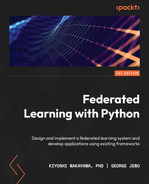Learn the essential skills for building an authentic federated learning system with Python and take your machine learning applications to the next level Federated learning (FL) is a paradigm-shifting technology in AI that enables and accelerates machine learning (ML), allowing you to work on private data. It has become a must-have solution for most enterprise industries, making it a critical part of your learning journey. This book helps you get to grips with the building blocks of FL and how the systems work and interact with each other using solid coding examples. FL is more than just aggregating collected ML models and bringing them back to the distributed agents. This book teaches you about all the essential basics of FL and shows you how to design distributed systems and learning mechanisms carefully so as to synchronize the dispersed learning processes and synthesize the locally trained ML models in a consistent manner. This way, you'll be able to create a sustainable and resilient FL system that can constantly function in real-world operations. This book goes further than simply outlining FL's conceptual framework or theory, as is the case with the majority of research-related literature. By the end of this book, you'll have an in-depth understanding of the FL system design and implementation basics and be able to create an FL system and applications that can be deployed to various local and cloud environments. This book is for machine learning engineers, data scientists, and artificial intelligence (AI) enthusiasts who want to learn about creating machine learning applications empowered by federated learning. You'll need basic knowledge of Python programming and machine learning concepts to get started with this book.Key Features
Book Description
What you will learn
Who this book is for
Table of Contents
- Federated Learning with Python
- Acknowledgments
- Contributors
- About the authors
- About the reviewer
- Preface
- Part 1 Federated Learning – Conceptual Foundations
- Chapter 1: Challenges in Big Data and Traditional AI
- Chapter 2: What Is Federated Learning?
- Chapter 3: Workings of the Federated Learning System
- Part 2 The Design and Implementation of the Federated Learning System
- Chapter 4: Federated Learning Server Implementation with Python
- Chapter 5: Federated Learning Client-Side Implementation
- Chapter 6: Running the Federated Learning System and Analyzing the Results
- Chapter 7: Model Aggregation
- Part 3 Moving Toward the Production of Federated Learning Applications
- Chapter 8: Introducing Existing Federated Learning Frameworks
- Chapter 9: Case Studies with Key Use Cases of Federated Learning Applications
- Chapter 10: Future Trends and Developments
- Appendix: Exploring Internal Libraries
- Index
- Other Books You May Enjoy
